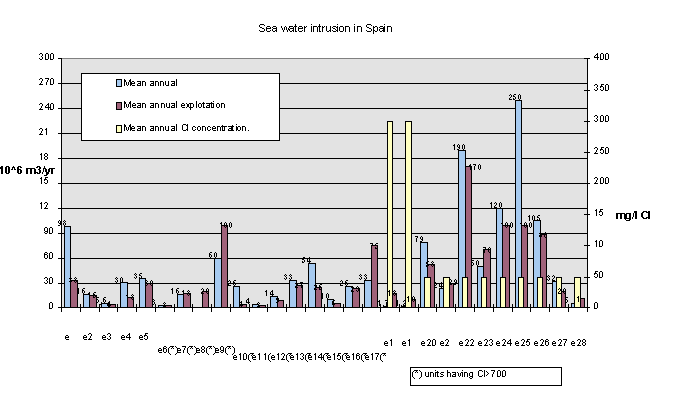3.7. Seawater
intrusion in coastal aquifers
The exploitation of coastal aquifers
always produces a lowering of the water table levels which are protected by the effects in
the coastal strip of the sea level. When the extracted volumes are greater than the
recharge, even on a local basis, a salinisation process begins in the aquifer as the
seawater flows upon the land. In the light of this, the management of coastal aquifers is
conditioned by the need to determine the maximum permissible penetration limit for each
particular aquifer (MOPTMA-MINER, 1984).
The problem of aquifer contamination
by seawater intrusion, together with the extent and seriousness of the problem, are mainly
conditioned by three factors: the difference between the respective densities of the fresh
and salt water, the hydrodynamic properties of the aquifer and the flow that the aquifer
discharges into the sea.
The first two factors are intrinsic
to the seawater intrusion problem regardless of the climate in the region. Furthermore,
these two parameters are fixed, and cannot be modified by the usual anthropogenic
activity. The flow that the aquifers discharge into the sea is conditioned by natural
conditions (from rainfall) or artificial recharge (mainly from irrigation) and by pumping.
Therefore, anthropogenic actions can bring about some modifications.
The main salinity problems in the
semi-arid zones of Europe are caused by a scarce recharge by rainfall. This problem is
further aggravated by the fact that the climates in these areas attracts an influx of
European tourism, especially in the summer months. Such a situation causes imbalances,
water shortage problems and costly and complicated management mechanisms.
Furthermore, the solutions that have
been usually adopted in the fight against saline intrusion, are rather inappropriate to
the semi-arid zones of Europe. The most common technique is to increase the groundwater
flow from the aquifers to the sea. Another is to recharge water reserves in technically
strategic coastal zones. However, it is difficult to obtain freshwater recharge sources in
semi-arid areas. Slightly diluted wastewater constitutes a further problem when attempting
to fight seawater intrusion and, finally, given that the recharge installations would have
to cover an extensive surface area, the availability of land for such purposes is both
scarce and costly and carries its own environmental impact.
3.7.1. Spain
A total of 58% of the 82 coastal
hydrogeological units in Spain and the Balearic Islands show some evidence of seawater
intrusion as a direct result of over-exploitation of the freshwater resources. In some
cases (7%) this is a local effect around the pumping area, while in others (33%) this
encroachment covers a larger area. In the rest (18%) this intrusion affects all the
aquifer or most of it (MOPTMA-MINER, 1994).
Figure 3.7-1 shows the aquifers with
saline intrusion problems in the Segura and Jucar catchment areas. There are some others
in the Balearic Islands and in the Catalan area, but these are not regarded as semi-arid
areas in the context of this report.

Figure 3.7.-1 Marine
intrusion in aquifers in semi-arid areas of Spain
Notes:
All of them are used for
human purposes. The mean annual Cl concentration are expressed as the lower limit.
* Guadiana basin:e1:
Ayamonte-Huelva
* Guadalquivir basin:e2: Rota-Sanlucar-Chipiona; e3: Puerto de Santa Maria; e4:
Puerto Real-Conil; e5: Vejer-Barbate
* Sur basin:e6: Bajo Almanzora; e7: Campos de Nijar; e8: Andarax-Almeria; e9: Campo
de Dalias; e10: Albulñol; e11: Carchona; e12: Rio Verde; e13: Velez; e14: Bajo
Guadalhorce; e15: Fuengirola; e16: Marbella-Estepona
* Segura basin:e17: Campo de Cartagena; e18: Mazarron; e19: Aguilas
* Jucar basin:e20: Plana de Vinaroz; e21: Plana de Oropesa; e22: Plana de
Castellon; e23: Plana de Sagunto; e24: Plana Valencia-Norte; e25: Plana Valencia Sur; e26:
Plna Gandia-Denia; e27: Peñon-Montgo-Bernia; e28: Orcheta.
3-7.2. Portugal
Problems in Portuguese aquifers are
of little extension and are not serious, these appear in Coast-Central Algarve and
Coast-Oriental Algarve, as Table 3.7-1 shows.
3.7.3. Italy
In the Island of Sardinia, there are
four aquifers having sea water intrusion as Table 3.7-1 shows; all of them are used for
human supply purposes.
Table 3.7.-1 Sea water intrusion in
Portugal and Italy (Sardinia)
Country |
Aquifer
name |
R
(*) |
E(**) |
Cl
(***) |
Portugal |
Coast-Central
Algarve |
25 |
10 |
450 |
| |
Coast-Oriental
Algarve |
50 |
50 |
723 |
Italy (Sardinia) |
S. Lucia |
6.8 |
4 |
180-3000 |
| |
Muravera
(Flumendosa) |
3.3 |
4.8 |
400-8000 |
| |
Villasimius Rio Foxi |
1.1 |
0.5 |
200-1000 |
Notes:
(*) R: Mean annual recharge
in 106 m3/year
(**) E: Mean annual exploitation in 106 m3/year
(***) Cl: Mean annual Cl concentration in mg/l
3.7.4. Greece
Marine intrusion problems have been
detected in ten hydrologic departments, particularly in coastal areas and in the Aegean
islands.


Document Actions
Share with others